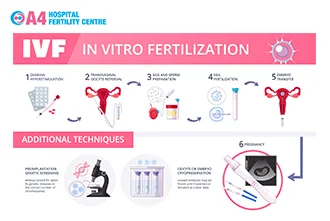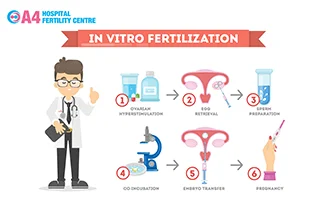
Dr. Aruna Ashok MBBS, MS OG, DNB OG
- Clinical Director

IVF is one of the most advanced procedures in the industry. In-vitro fertilization involves fertilizing the collected sperm and egg in a controlled environment. The fertilized egg is kept in a controlled chemical environment and the embryo is planted in the uterus of the female partner. This has been the most important breakthrough in the field of reproductive medicine. Now we are going to take a look at some of the most frequently asked questions before undertaking an IVF procedure. We will look into some of the other questions related to the IVF procedure.


Embryo freezing is done by vitrification. This method is a successful way of cryo-preservation of the embryos. Those embryos can be transferred later. The aim of the IVF process is not to produce a single embryo but a cluster of multiple embryos to increase the cumulative live birth rate. The preserved embryos can be used for the second child and the second embryo transfer in case of the failure of the first ET. Hence, it is always advisable to use cryopreservation in the process of IVF. The patient who becomes positive after the fresh ET can freeze the remaining embryos which can be used for future purposes. The embryos can be discarded after one year of delivery in case of not a requirement.
Each cryo-lock can hold two blastocyst embryos. In the case of only one embryo, 1 cryo-lock can be loaded with only one embryo. Cryolock is useful for storing surplus embryos. The system is safe and secure. It is advisable to freeze at least 8 blastocyst embryos when the supply of embryos is surplus. If the couple wants all the embryos to be frozen, the procedure can be availed without any problem. When the cryofreezing is done, the embryos remain in the frozen state. The success rate of IVF is independent of the time taken between the freezing and the embryo transfer. Women have higher chances of twin pregnancy with IVF procedures when more than one embryo is transferred. At times, one could have a non-identical twin after IVF especially if the blastocyst embryo has been transferred. The chances of twins in a normal pregnancy are around 6% while the chances of twins with an IVF procedure reach up to 25%. Apart from this blog, you can get additional information at the I.S.A.R (Indian Society for Assisted Reproduction) (isarindia.net)
Embryo transfer is an important process in the IVF procedure. The main idea behind the double embryo transfer is to increase the rate of pregnancy. The pregnancy rate of the double embryo transfer is 10-15% higher than the pregnancy rate of the single embryo transfer. The chance of getting twin delivery is also high with Double Embryo Transfer. This twin pregnancy is also not a compulsion with IVF and the patient with previous twin miscarriages, cervical incompetence, unicornuate uterus, heart disease, secondary infertility with one live child, etc., are not advised to have a twin pregnancy. They should have a single embryo transfer.
Many pregnant women give birth prematurely and the child born out of the pregnancy is underweight and weak. Survival becomes a hard process for both the parents and the children. The risk of early and late miscarriages is also higher when compared to a singleton pregnancy. If multiple pregnancies are thought to cause serious health threats to the mother or children. The doctors suggest a fetal reduction procedure. Fetal reductions are with a risk of 2% miscarriages. Single Embryo transfer is preferred for patients who doesn’t want twins, or mother with a medical illness like heart disease, hypertension, and diabetes, PGTA is a necessary process for single embryo transfer.
There is no restriction on the physical activity until the process of egg retrieval. But the process of hyper stimulation of ovaries might induce pain and discomfort in the lower abdomen after 6-7 days of injections. This is a usual process. It is better to avoid physical activity to prevent torsion or pain in the abdomen. After the Embryo transfer, physical activity is not advisable until the doctor advice the patient to take it up. It is better to have good foods during the IVF procedure.